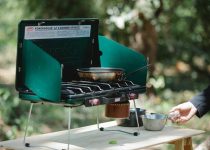Outdoor Pizza Perfection Using a Pizza Steel on Your Grill in 3 Key Steps
To discover the perfect outdoor pizza using a pizza steel on your grill, follow these three essential steps. First, prep your pizza steel by cleaning it and seasoning with a high-smoke point oil; place it centrally on the grill for an even heat distribution. Next, craft your dough using high-protein flour to hit a 60-70% hydration level, and let it ferment slowly in the fridge for up to 72 hours. Finally, get your grill hot—aim for about 500°F, using indirect heat to avoid burning. Preheat your steel for 20 minutes for that ideal crispy crust. Master these, and you'll reveal even more secrets to pizza perfection!
Table of Contents
Key Takeaways
- Preheat the pizza steel on the grill at 500°F for 20 minutes to ensure even cooking.
- Use a high-protein flour and hydrate at 60-70% for a crispy crust.
- Ferment the dough slowly in the fridge for 24-72 hours to enhance flavors.
- Position the pizza steel centrally for consistent heat distribution.
- After cooking, clean and season the steel to maintain its non-stick properties.
Preparing Your Pizza Steel
Before firing up your grill, make sure your pizza steel is clean and properly seasoned. You wouldn't want last week's flavors mingling with tonight's masterpiece. Scrub off any residue with a stiff brush and hot water. Skip the soap—it can linger and affect the taste.
Once it's clean, you'll need to season it. Apply a thin layer of high-smoke point oil, like flaxseed or canola, and heat your steel in the grill at a high temperature until it starts to smoke. This process not only guarantees sticking but also protects the steel from rust.
When it comes to steel placement, positioning is key to an evenly cooked pizza. Center your steel on the grill to make sure it receives consistent heat. Avoid placing it too close to the flames to prevent hot spots that can lead to burning.
For maintenance tips, after each use, let the steel cool completely before cleaning. Regular seasoning after cleaning maintains its non-stick properties and prevents oxidation.
Mastering these steps ensures your pizza steel is always ready for action, turning your grill into a pizza-making powerhouse.
Crafting the Perfect Dough
Now that your pizza steel is prepped, let's focus on crafting the perfect dough. The key to a memorable, pizzeria-quality crust lies in understanding and controlling hydration levels and fermentation times.
Here's how you can master this art:
- Optimize Hydration Levels:
Begin by selecting a flour with high protein content; this will handle higher hydration levels, which are essential. Aim for a hydration level between 60% and 70%. This means for every 100 grams of flour, use 60 to 70 grams of water. High hydration leads to a dough that's airy and can create those sought-after crispy, bubbly textures once cooked.
- Manage Fermentation Times:
Fermentation is where the magic happens. Slow ferment your dough in the refrigerator for at least 24 hours, ideally up to 72 hours. This prolonged fermentation allows the dough to develop a complex flavor and improve its digestibility. The slow process also helps in gluten development, making your dough stretchy and less prone to tearing.
- Knead for Consistency:
Knead your dough until it's smooth and elastic. This ensures an even rise and texture in your pizza crust. You're looking for a silky, pliable ball that springs back slightly when poked.
Mastering Grill Temperatures
To achieve the perfect crust, you'll need to master the temperature of your grill. Temperature monitoring is essential; you can't guess your way to perfection. Invest in a good quality grill thermometer. You're aiming for a hot 500°F (260°C) to mimic a traditional pizza oven. This high heat helps in achieving that crispy base and beautifully melted toppings.
Now, understanding indirect heating is key. This method involves heating one section of the grill to the desired temperature, while the area where you place your pizza isn't directly over the flames. Set up your grill by turning on only half the burners or piling the charcoal on one side. This creates a hot zone for preheating your pizza steel and a cooler zone where your pizza will cook through more evenly without burning the bottom.
Place your pizza steel on the grill to heat up for at least 20 minutes before sliding your pizza onto it. This step ensures your steel is blisteringly hot, ready to cook the dough swiftly and evenly. Keep a close eye on the temperature throughout the cooking process. Slight adjustments might be necessary to maintain that perfect heat. Remember, mastering your grill's temperature is your secret weapon for outdoor pizza perfection.
Frequently Asked Questions
Can a Pizza Steel Be Used on Any Type of Grill?
Yes, you can use a pizza steel on any type of grill. It's all about grill compatibility and ensuring even heat distribution, so you'll get that perfect crust you're aiming for.
How Do I Clean My Pizza Steel After Use?
To clean your pizza steel, let it cool, then scrub with water and a stiff brush. Dry thoroughly; apply a light oil coat for rust prevention. Store in a dry area to maintain it.
Is Seasoning a Pizza Steel Necessary?
You don't need to season your pizza steel, but it can enhance flavor impact and provide extra benefits like rust protection and non-stick properties. It's worth considering if you're after excellent results.
How Long Does a Pizza Steel Last With Regular Use?
With regular use, your pizza steel's durability hinges largely on usage frequency and care. Typically, it'll last years if you're maintaining it properly—avoid rust and keep it clean after each bake.
Can I Cook Other Foods Besides Pizza on a Pizza Steel?
Yes, you can cook various foods on a pizza steel. Its versatility extends to baking bread, roasting vegetables, and searing meats, optimizing grilling dynamics to enhance flavors and achieve perfect cooking results.



